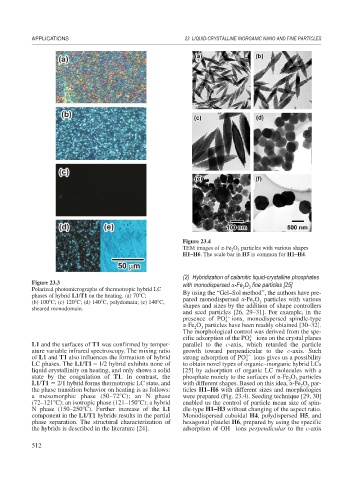Page 540 - Book Hosokawa Nanoparticle Technology Handbook
P. 540
APPLICATIONS 23 LIQUID-CRYSTALLINE INORGANIC NANO AND FINE PARTICLES
Figure 23.4
TEM images of -Fe O particles with various shapes
2
3
H1–H6. The scale bar in H5 is common for H1–H4.
(2) Hybridization of calamitic liquid-crystalline phosphates
Figure 23.3 with monodispersed -Fe O fine particles [25]
Polarized photomicrographs of thermotropic hybrid LC 2 3
phases of hybrid L1/T1 on the heating. (a) 70 C; By using the “Gel–Sol method”, the authors have pre-
3
2
(b) 100 C; (c) 120 C; (d) 140 C, polydomain; (e) 140 C, pared monodispersed -Fe O particles with various
sheared monodomain. shapes and sizes by the addition of shape controllers
and seed particles [26, 29–31]. For example, in the
3
presence of PO ions, monodispersed spindle-type
4
-Fe O particles have been readily obtained [30–32].
2
3
The morphological control was derived from the spe-
cific adsorption of the PO 3 ions on the crystal planes
4
L1 and the surfaces of T1 was confirmed by temper- parallel to the c-axis, which retarded the particle
ature variable infrared spectroscopy. The mixing ratio growth toward perpendicular to the c-axis. Such
of L1 and T1 also influences the formation of hybrid strong adsorption of PO 3 ions gives us a possibility
4
LC phases. The L1/T1 1/2 hybrid exhibits none of to obtain novel types of organic–inorganic hybrid LCs
liquid crystallinity on heating, and only shows a solid [25] by adsorption of organic LC molecules with a
state by the coagulation of T1. In contrast, the phosphate moiety to the surfaces of -Fe O particles
2
3
L1/T1 2/1 hybrid forms thermotropic LC state, and with different shapes. Based on this idea, -Fe O par-
3
2
the phase transition behavior on heating is as follows: ticles H1–H6 with different sizes and morphologies
a mesomorphic phase (50–72 C); an N phase were prepared (Fig. 23.4). Seeding technique [29, 30]
(72–121 C); an isotropic phase (121–150 C); a hybrid enabled us the control of particle mean size of spin-
N phase (150–250 C). Further increase of the L1 dle-type H1–H3 without changing of the aspect ratio.
component in the L1/T1 hybrids results in the partial Monodispersed cuboidal H4, polydispersed H5, and
phase separation. The structural characterization of hexagonal platelet H6, prepared by using the specific
the hybrids is described in the literature [24]. adsorption of OH ions perpendicular to the c-axis
512

